Legacies (U.K.): latest statistics & impact of Covid 19

07/04/2020 - Remember A Charity - Rob Cope: 'Why the pandemic stopped legacy income in its tracks'
- Supporters’ legacy gifts are tied up in estates that are unlikely to be processed for months or more.
- Both the property and stock market have suffered major losses
- Of course, the situation is temporary – legacy gifts will be processed
- Surge in will-writing: recent weeks have seen a massive surge in will-writing, with charities reporting increases of up to 500% in online will-writing enquiries.
17-03-2020 - Legacy Foresight – 'The potential impact of Covid-19 on the legacy market'.
A recent contribution of Chris Farmelo, Technical Director, Legacy Foresight, explains how Covid-19 could impact on legacies in the U.K. via a range of quite separate mechanisms: economic, demographic, etc.
25-02-2020 - Legacy Foresight – ‘Legacy notifications down in 2019, but income grew’
Legacy Foresight is currently updating its legacy market models and will produce new quantitative forecasts of legacy income over the next five years, including both central and worst case scenarios.
According to the 82 Legacy Monitor consortium members of Legacy Foresight, during the 12 months to December 2019 the total bequest numbers were 9% down while income was up 6.6%.
Some unusually large bequests might have bolstered income growth in early 2019.
The decrease of bequest numbers might be primarily due to the widely reported delays at probate courts.
-> Lien vers tous les articles 'Covid-19 & fundraising'
France: lancement de la plateforme Alliance Urgences
Mobiliser la générosité des Français en situation d'urgence humanitaire
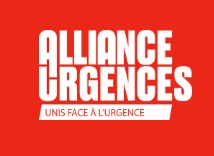 15/03/2020 - La Belgique - au travers du Consortium 12-12 - de même que nombre d'autres pays disposent depuis nombre d'années d'une plateforme nationale regroupant la plupart des organisations susceptibles d'intervenir efficacement lors de crises humanitaires majeures.
15/03/2020 - La Belgique - au travers du Consortium 12-12 - de même que nombre d'autres pays disposent depuis nombre d'années d'une plateforme nationale regroupant la plupart des organisations susceptibles d'intervenir efficacement lors de crises humanitaires majeures.
->Lire: Plateformes nationales membres de l'Emergency Appeals Alliance.
La structure française Alliance Urgences a été fondée en début d'année 2020.
Elle s'est assignée un triple objectif:
- Offrir un mécanisme de réponse unique et coordonné aux situations d’urgences humanitaires dans le but d’augmenter les montants collectés.
- Simplifier le paysage humanitaire Français en jouant le rôle de coordinateur entre les ONG, les médias et les citoyens lors d’urgences humanitaires.
- Renforcer l’élan de solidarité nationale autour des crises humanitaires médiatisées ou traditionnellement « oubliées ».
La plateforme française se dote progressivement d'outils de collecte fonctionnels (site Internet, centre d’appel, base de données, etc.), d'éléments de communication prêts à l’emploi (film de présentation, bannières publicitaires, etc.) et de partenariats médias solides (Groupes TV, radios, réseaux sociaux, affichage, opérateurs téléphoniques, etc.).
Elle a choisi de rôder son fonctionnement en lançant début 2020 un premier appel 'Urgence Rohingyas'.
Organisations membres de la plateforme
L’Alliance Urgences regroupe six ONG Françaises qui estiment légitime de se mobiliser dans le cadre d'urgences humanitaires. Une clé de répartition des dons a été définie en fonction de la capacité d'intervention de chaque organisation: Action contre la Faim (28,5%), CARE (5,7%), Handicap International (27,5%), Médecins du Monde (28,1%), Plan International (7,4%), Solidarités Internationales (2,8%).
On notera que Médecins sans Frontières et la Croix-Rouge française ne font pas partie de la plateforme française bien qu'elles disposent d'équipes et de moyens logisitques qui leur permettent d'intervenir efficacement en situation d'extrème urgence. Ces structures, pour lesquelles l'action humanitaire en urgence fait partie de leur 'core business', n'estiment pas nécessairement pertinent de s'associer au sein d'une même plateforme aux côtés d'organisations dont les capacités d'intervention rapide et efficace lors de crises humanitaires semblent parfois moins avérées.
Urgence Coronavirus
Comme dans le cas des autres plateformes nationales qui font appel à la générosité publique lors de crises humanitaires, les ONG membres d'Alliance Urgences disposent de moyens d'intertvention qui sont principalement ou exclusivement déployés dans les pays du Sud.
Sauf exceptions il leur est difficile d'intervenir efficacement dans leur propre pays, par exemple en faveur des victimes du Coronavirus sur le continent européen.
Les six ONG membres d'Alliance Urgences ont lancé dès début avril un appel 'Urgence Coronavirus' destiné à soutenir l'aide aux victimes de la pandémie en France ainsi que dans les pays du Sud (lien).
La situation est quelque peu différente au Royaume-Uni.
L'incendie de la Grenfell Tower (juin 2017) a mis en valeur que la plateforme britannique DEC (Disaster Emergency Committee), dont les ONG membres sont surtout présentes dans les pays du Sud, pouvait difficilement mobiliser la solidarité des britanniques en faveur d'une urgence qui se déroulait au coeur de Londres.
Ce constat a amené la création du National Emergency Trust, qui mobilise dès à présent la générosité des britanniques en faveur des associations locales qui viennent en aide aux victimes dans différentes régions du Royaume-Uni.
->Lire: 'Coronavirus: appeal launched for UK charities'
Royaume-Uni: causes de mécontentement des donateurs
Mission du Fundraising Regulator
 Le Fundraising Regulator, autorité britannique de régulation des organisations qui font appel à la générosité publique, a été créé en juillet 2016.
Le Fundraising Regulator, autorité britannique de régulation des organisations qui font appel à la générosité publique, a été créé en juillet 2016.
Il publie sur base annuelle un Complaints Report, téléchargeable au départ du lien suivant, qui présente une synthèse des principales causes de plaintes communiquées par les donateurs britanniques.
Ces données fournissent des indications utiles concernant les méthodes de collecte qui provoquent le mécontentement de certains donateurs. De ce point de vue ce rapport intéresse également les organisations caritatives actives en dehors du Royaume-Uni.
Fréquence des plaintes par canal de communication
La seconde partie du rapport, intitulé 'Complaints reported by the charity sector', illustre à quel point les organisations britanniques sont tenues de publier des données particulièrement détaillées concernant le traitement des plaintes qui leur sont adressées.
Quelque 20.541 plaintes ont été enregistrées sur la période 2018-2019, soit une baisse de 5% par rapport à l’année précédente.
Le tableau ci-dessous, qui présente une compilation des résultats pour les 53 principaux acteurs de la collecte, indique que leurs canaux de communication ou de contact ont tous bénéficié d'une diminution des plaintes en 2018-2019, à l'exception du direct mail.
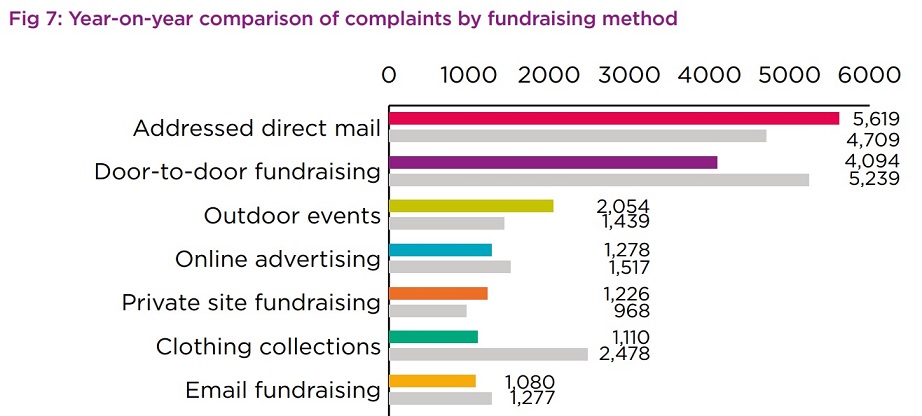

Les données que les organisations sont tenues de transmettre au Fundraising Regulator fournissent des indications précises pour chaque méthode de collecte:
a. total des contacts par méthode de collecte
b. nombre de réclamations enregistrées par ces organisations au cours des deux années précédentes (confer montants ci-dessus)
c. importance relative de la fréquence des plaintes (ratio b/a)
Les principales plaintes identifiées dans le rapport concernent :
- Addressed direct mail (79 million items sent)
5.619 complaints, ratio 1:13.000
- Door-to-door fundraising (25 million contacts):
4.094 complaints, ratio 1:5.000 contacts
- Email fundraising (96 million email sent)
1.080 complaints reported, ratio 1:89.000
- Telephone fundraising: (2 million people called)
550 complaints reported, ratio 1:3.900 contacts
- Street fundraising (1,9 million sign-ups):
349 complaints, ratio 1:3.500
Le pourcentage de plaintes semble à l'évidence particulièrement faible en comparaison avec le total des contacts générés par chaque méthode de collecte.
Addressed direct mail
Les mailings adressés aux donateurs ont connu une croissance des plaintes alors que ce canal de communication est globalement en recul, de 98 à 79 millions d’envois par an. Les motifs d'insatisfaction concernent principalement la fréquence des envois (27%) ainsi que les courriers accompagnés d’objets divers (11%).
Street fundraising
Le rapport ne permet pas de comparer l'importance relative, au Royaume-Uni, du street fundraising par rapport au door-to-door fundraising (recrutement de donateurs en porte-à-porte). Mais il semble que cette seconde approche suscite davantage la réprobation d'une frange du public.
Enquêtes diligentées par le Fundraising Regulator
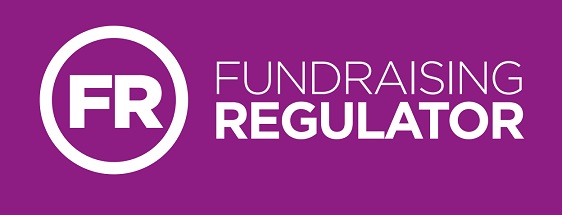 Le rapport fournit des précisions concernant 737 plaintes qui furent directement adressées au Fundraising Regulator.
Le rapport fournit des précisions concernant 737 plaintes qui furent directement adressées au Fundraising Regulator.
- 37% des notifications ont été jugées prématurées parce que le donateur s’était adressé au Fundraising Regulator avant de tenter de solutionner son litige en contactant directement l’association concernée,
- 44% des dossiers ont été transférés à d’autres instances, telle la Charity Commission, plus spécifiquement habilitées à traiter ce type de demandes
- 82 dossiers furent investigués par le Fundraising Regulator et permirent d’identifier trois problèmes récurrent.
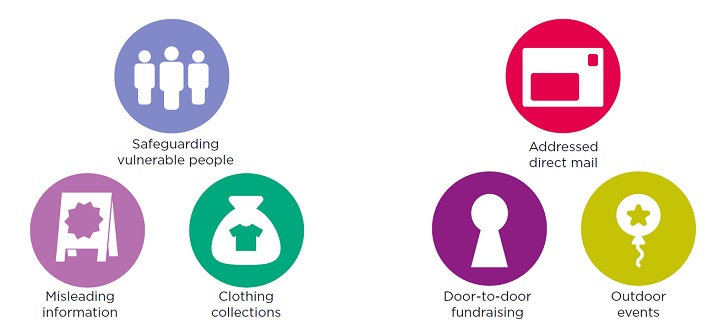 Problèmes récurrents
Problèmes récurrents
Themes from our investigations
- 20 (24%) related to the treatment of vulnerable donors
- 18 (22%) related to misleading information in fundraising communications
- 11 (13%) related to 'no charity bag' signs on properties not being observed
1 - Safeguarding vulnerable people
Cette thématique concerne des personnes vulnérables (souvent âgées) qui se sentent déstabilisées par l’envoi persistant d’appels à la générosité.
Ce type de contentieux fut précisément à l'origine des démarches qui amenèrent la création, en 2016, du Fundraising Regulator.
Cette instance publiera dans le courant de l’année 2020 un guide de bonnes pratiques qui traitera cette thématique.
2 - Misleading information
Le rapport cite à titre d’exemple une plainte qui est apparue en définitive non-fondée.
3 - Clothing collections
Les plaintes de cette catégorie concernent notamment la pollution causée par le dépôt systématique, sans demande explicite des usagers et malgré l’apposition d’un logo ‘no charity bags’, de sacs en plastique destinés à des collectes de vêtements.
Complaints handling
Un nombre singificatif de donateurs semble d'avis que leur démarche n’a pas été traitée de manière appropriée par l’organisation.
D’où la recommandation du Fundraising Regulator: ‘The code requires charities and third-party fundraising organisations to have in place an effective complaints handling process.’
Fundraising Preference Service
2.820 donateurs ont contacté au cours de cette année le Fundraising Preference Service en vue de mettre fin à 8,719 envois d’appels aux dons émanant de 846 organisations.
Quelques plaintes émanent de donateurs qui ont fait connaître via le Fundraising Preference Service le souhait de ne plus recevoir d’appels aux dons, et estiment que leur n’a pas été prise en compte.
La lecture de ce rapport ne manquera pas de susciter quelque perpléxité auprès des fundraisers actifs en dehors du Royaume-Uni.
Ils se sentiront soit admiratifs à l'égard d'une procédure particulièrement exhaustive de documentation de l'ensemble des plaintes adressées par les donateurs britanniques, soit dubitatifs quant au rapport coût-efficacité de ce comptage particulièrement fastidieux des imperfections imputables au secteur de la collecte de fonds.
Relevons, parmi les points d'attention qui concernant également les fundraisers du continent européen, les problèmes causés par la fréquence des appels aux dons envoyés par certaines organisations, ainsi que l'irritation causée par les campagnes de recrutement de donateurs en porte-à-porte.
Source
Fundraising Regulator - 'Complaints Report 2018-1019'
Voluntary income in the U.K. (2001-2016)
 First published in 1996, the UK Civil Society Almanac is the definitive resource on the state of the voluntary sector.
First published in 1996, the UK Civil Society Almanac is the definitive resource on the state of the voluntary sector.
Two main resources from the public
The public accounts for almost half (45%) of voluntary organisations’ total income.
- Voluntary income: half of the money from the public (50%) is ‘voluntary income’ in the form of donations, such as bucket collections or direct debits, and legacies – money that people give to voluntary organisations in their wills.
- Earned income: the rest comes from ‘earned income’, where people get something in return. It encompasses ‘income from charitable activities’ like fees paid for goods and services, membership subscriptions, etc.
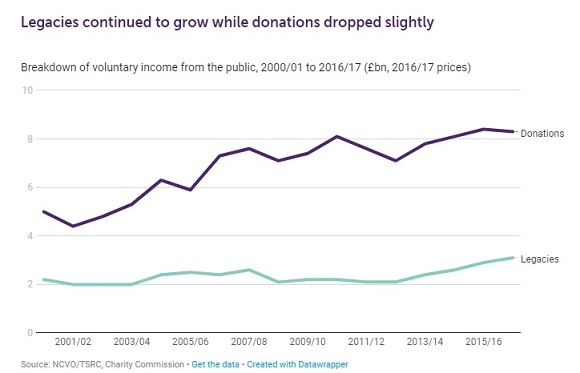 Major trends
Major trends
Income from the public has seen a slight dip for the first time since 2008/09.
Legacies continued to grow while donations dropped slightly.
Donations from the public fell slightly by 2%, from £8.4bn to £8.3bn. They represent 16% of the sector’s total income.
Split by size
Voluntary income
The public are the largest income source for voluntary organisations of all sizes.
Micro and small voluntary organisations receive 59% of their income from the public, while this proportion is lower for larger organisations (41%-48%).
Despite an overall drop, income from the public was up for super-major organisations (due to significant growth in legacies) and large voluntary organisations, for which income from the public grew across all types (donations, legacies, earned).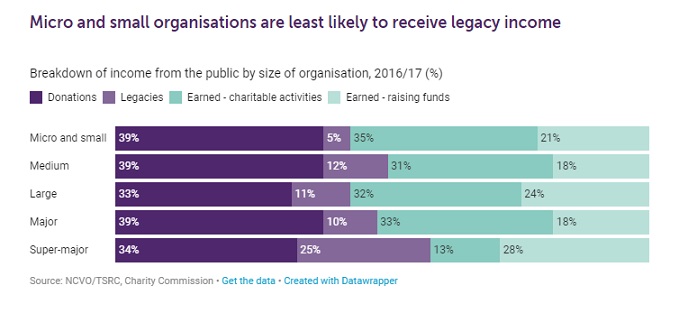 Legacies
Legacies
Over the last five years legacies have grown by 50%.
Legacy income was up across organisations of all sizes, except for major organisations (£1 to £10m).
The rise in legacy income might be linked to changes in financial reporting as much as a real trend.
Although legacy income has grown overall, micro and small voluntary organisations are least likely to receive money from the public in that way.
Only 5% of money from the public was in form of legacies for these organisations, while this was 25% for super-major voluntary organisations in 2016/17.
Donations
The proportion of donations is fairly similar across voluntary organisations of different sizes ranging between 33% and 39%.
Explaining the slight drop in donations
During 2016 donations from the public have seen a slight drop after three years of growth.
However, it’s too early to say whether this will be a continued trend.
Some have been quick to link this drop with falling levels of trust in voluntary organisations.
However, other factors shouldn’t be overlooked.People are being asked less.
_ With the implementation of GDPR, voluntary organisations everywhere have done a huge amount of work to clean and update their supporters databases, with occasional or lapsed donors the supporters most likely to have been removed.
- The way people are doing good is changing. For example, the market for ethical goods and services has grown rapidly over the last two decades and the rise of fundraising platforms and individuals asking directly for support has in some cases removed the role of voluntary organisations as an intermediary, trusted or otherwise.
Explaining the growth in legacy income
Over the last five years, the sector has seen continuous growth in legacy income with the biggest jump in recent years.
This trend can be explained by various factors.
- At death the greatest asset is usually a home and its value dependent on the state of the market. The growth in legacy income since 2011/12 could therefore be linked to a recovering economy and increased property prices.
- The rise in the number of deaths may also be a contributing factor.
- In addition, with the new financial reporting standard FRS 102 legacy income is recognised when receipt is ‘probable’ rather than the previous criteria of "virtually certain". This may have resulted in more legacy income being recognised earlier and contributed to its growth.
- It might further be explained by some voluntary organisations changing their fundraising strategies and increasing their efforts to raise legacy income.
Sources
This article is a summary of a recent on-line publication of the NCVO: 'How much do voluntary organisations get from the public?' (link)
Covid-19: fundraising tips (1)
Recommandations from various sources
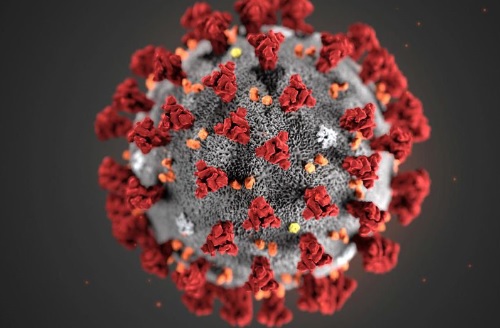 We list in this article, as well as in other articles listed below, various contributions related to fundraising advice in times of coronavirus.
We list in this article, as well as in other articles listed below, various contributions related to fundraising advice in times of coronavirus.
09/03/2020 - CLAIRification - 'How Nonprofits Can Connect Virtually During Trying Times'
(Claire)
Why not invite your supporters for some online gatherings?
Beef up your virtual meeting facilitation skills!
Remember to follow through so your meeting has meaning and meets its purpose.
My best advice: be there for your supporters today, they’ll be there for you tomorrow.
-> link
12/03/2020 - Institute of Fundraising - 'Love for fundraisers in a time of coronavirus'
(Howard Lake)
1. Look after yourself and those who give you strength
2. Be ready for a huge amount of fundraising
3. People always want to give
4. Learn from and record this experience
5. Your digital presence is your presence
6. Avoid distraction
7. Collaborate and survive
8. Read, watch and study to become a better fundraiser
-> link
12/03/2020 sgEngage - 'Tips for Communicating with Donors During Uncertain Times'
(Bo Crader)
Focus on Your Mission
Focus on the Basics
Focus on Communicating with Donors: show empathy, continue to ask for gifts, don’t be sensational or exploitative, try something different, cultivate high-value supporters
-> link
12/03/2020 - Network for Good - 'Coronavirus Impacting Your Nonprofit? Here’s What to Do'
A few ideas that can help your fundraising stay on track: virtual events, dinner with a twist, virtual auction, flash fundraiser, sharable content, appreciate more often.
Successful fundraising during a recession is two-pronged:
1 - focus hard on donor engagement and retention,
2 - use intelligent prospecting techniques to recruit new followers and supporters.
-> link
13/03/2020 Fondsenwerving.blog - 'Vrijdag de 13e: het coronavirus en fondsenwerving'
(Reinier Spruyt)
13 tips, waaronder:
Zou je die (oudere) donateurs niet eens opbellen?
Coronavirus: Misschien een goede aanleiding om je beleid te herzien?
Wellicht kan een zorgprofessional je volgende appeal ondertekenen?
Leg niet opeens je hele fondsenwerving programma stil.
-> link
-> Lien vers tous les articles 'Covid-19 & fundraising'











